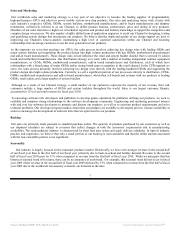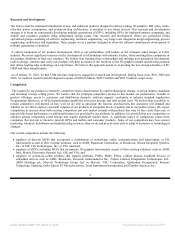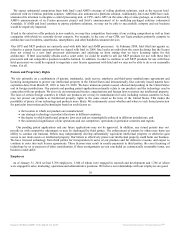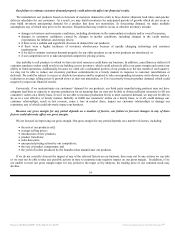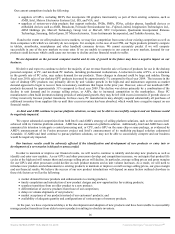NVIDIA 2010 Annual Report Download - page 15
Download and view the complete annual report
Please find page 15 of the 2010 NVIDIA annual report below. You can navigate through the pages in the report by either clicking on the pages listed below, or by using the keyword search tool below to find specific information within the annual report.
Research and Development
We believe that the continued introduction of new and enhanced products designed to deliver leading 3D graphics, HD video, audio,
ultra-low power consumption, and system-on-chip architectures is essential to our future success. Our research and development
strategy is to focus on concurrently developing multiple generations of GPUs, including GPUs for high-performance computing, and
mobile and consumer products using independent design teams. Our research and development efforts are performed within
specialized groups consisting of software engineering, hardware engineering, very large scale integration design engineering, process
engineering, architecture and algorithms. These groups act as a pipeline designed to allow the efficient simultaneous development of
multiple generations of products.
A critical component of our product development effort is our partnerships with leaders in the computer aided design, or CAD,
industry. We invest significant resources in the development of relationships with industry leaders, often assisting these companies in
the product definition of their new products. We believe that forming these relationships and utilizing next-generation development
tools to design, simulate and verify our products will help us remain at the forefront of the 3D graphics market and develop products
that utilize leading-edge technology on a rapid basis. We believe this approach assists us in meeting the new design schedules of PC
OEM and other manufacturers.
As of January 31, 2010, we had 3,940 full-time employees engaged in research and development. During fiscal years 2010, 2009 and
2008, we incurred research and development expense of $908.9 million, $855.9 million and $691.6 million, respectively.
Competition
The market for our products is intensely competitive and is characterized by rapid technological change, evolving industry standards
and declining average selling prices. We believe that the principal competitive factors in this market are performance, breadth of
product offerings, access to customers and distribution channels, software support, conformity to industry standard Application
Programming Interfaces, or APIs, manufacturing capabilities, processor pricing, and total system costs. We believe that our ability to
remain competitive will depend on how well we are able to anticipate the features and functions that customers will demand and
whether we are able to deliver consistent volumes of our products at acceptable levels of quality and at competitive prices. We expect
competition to increase from both existing competitors and new market entrants with products that may be less costly than ours, or
may provide better performance or additional features not provided by our products. In addition, it is possible that new competitors or
alliances among competitors could emerge and acquire significant market share. A significant source of competition comes from
companies that provide or intend to provide GPUs and mobile and consumer products. Some of our competitors may have greater
marketing, financial, distribution and manufacturing resources than we do and may be more able to adapt to customer or technological
changes.
Our current competitors include the following:
• suppliers of discrete MCPs that incorporate a combination of networking, audio, communications and input/output, or I/O,
functionality as part of their existing solutions, such as AMD, Broadcom Corporation, or Broadcom, Silicon Integrated Systems,
Inc., or SIS, VIA Technologies, Inc., or VIA, and Intel;
• suppliers of GPUs, including MCPs that incorporate 3D graphics functionality as part of their existing solutions, such as AMD,
Intel, Matrox Electronics Systems Ltd., SIS, and VIA; and
• suppliers of system-on-a-chip products that support netbooks, PNDs, PMPs, PDAs, cellular phones, handheld devices or
embedded devices such as AMD, Broadcom, Freescale Semiconductor Inc., Fujitsu Limited, Imagination Technologies Ltd.,
ARM Holdings plc, Marvell Technology Group Ltd, or Marvell, NEC Corporation, Qualcomm Incorporated, Renesas
Technology, Samsung, Seiko-Epson, ST Microelectronics, Texas Instruments Incorporated, and Toshiba America, Inc.;
9
Source: NVIDIA CORP, 10-K, March 18, 2010 Powered by Morningstar® Document Research℠










